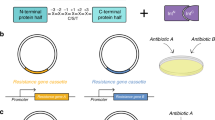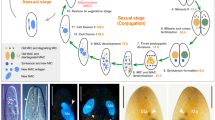Abstract
Conditional or temperature-sensitive (TS) alleles represent useful tools with which to investigate gene function. Indeed, much of our understanding of yeast has relied on temperature-sensitive mutations which, when available, also provide important insights into other model systems. However, the rarity of temperature-sensitive alleles and difficulty in identifying them has limited their use. Here we describe a system to generate temperature-sensitive alleles based on conditionally active inteins. We have identified temperature-sensitive splicing variants of the yeast Saccharomyces cerevisiae vacuolar ATPase subunit (VMA) intein inserted within Gal4 and transferred these into Gal80. We show that Gal80-inteinTS is able to efficiently provide temporal regulation of the Gal4/upstream activation sequence (UAS) system in a temperature-dependent manner in Drosophila melanogaster. Given the minimal host requirements necessary for temperature-sensitive intein splicing, this technique has the potential to allow the generation and use of conditionally active inteins in multiple host proteins and model systems, thereby widening the use of temperature-sensitive alleles for functional protein analysis.
This is a preview of subscription content, access via your institution
Access options
Subscribe to this journal
Receive 12 print issues and online access
$209.00 per year
only $17.42 per issue
Buy this article
- Purchase on Springer Link
- Instant access to full article PDF
Prices may be subject to local taxes which are calculated during checkout



Similar content being viewed by others
References
Tian, J. et al. A temperature-sensitive mutation in the nodal-related gene cyclops reveals that the floor plate is induced during gastrulation in zebrafish. Development 130, 3331–3342 (2003).
Harris, S.D., Cheng, J., Pugh, T.A. & Pringle, J.R. Molecular analysis of Saccharomyces cerevisiae chromosome I. On the number of genes and the identification of essential genes using temperature-sensitive-lethal mutations. J. Mol. Biol. 225, 53–65 (1992).
Paulus, H. Protein splicing and related forms of protein autoprocessing. Annu. Rev. Biochem. 69, 447–496 (2000).
Noren, C.J., Wang, J. & Perler, F.B. Dissecting the Chemistry of Protein Splicing and Its Applications. Angew. Chem. Int. Ed. Engl. 39, 450–466 (2000).
Poland, B.W., Xu, M.Q. & Quiocho, F.A. Structural insights into the protein splicing mechanism of PI-SceI. J. Biol. Chem. 275, 16408–16413 (2000).
Chong, S., Williams, K.S., Wotkowicz, C. & Xu, M.Q. Modulation of protein splicing of the Saccharomyces cerevisiae vacuolar membrane ATPase intein. J. Biol. Chem. 273, 10567–10577 (1998).
Adam, E. & Perler, F.B. Development of a positive genetic selection system for inhibition of protein splicing using mycobacterial inteins in Escherichia coli DNA gyrase subunit A. J. Mol. Microbiol. Biotechnol. 4, 479–487 (2002).
Derbyshire, V. et al. Genetic definition of a protein-splicing domain: functional mini-inteins support structure predictions and a model for intein evolution. Proc. Natl. Acad. Sci. USA 94, 11466–11471 (1997).
Winston, F., Dollard, C. & Ricupero-Hovasse, S.L. Construction of a set of convenient Saccharomyces cerevisiae strains that are isogenic to S288C. Yeast 11, 53–55 (1995).
Hirata, R. & Anraku, Y. Mutations at the putative junction sites of the yeast VMA1 protein, the catalytic subunit of the vacuolar membrane H(+)-ATPase, inhibit its processing by protein splicing. Biochem. Biophys. Res. Commun. 188, 40–47 (1992).
Cooper, A.A., Chen, Y.J., Lindorfer, M.A. & Stevens, T.H. Protein splicing of the yeast TFP1 intervening protein sequence: a model for self-excision. EMBO J. 12, 2575–2583 (1993).
Yocum, R.R. & Johnston, M. Molecular cloning of the GAL80 gene from Saccharomyces cerevisiae and characterization of a gal80 deletion. Gene 32, 75–82 (1984).
Fukasawa, T. & Nogi, Y. Molecular genetics of galactose metabolism in yeast. Biotechnology 13, 1–18 (1989).
Lee, T. & Luo, L. Mosaic analysis with a repressible cell marker for studies of gene function in neuronal morphogenesis. Neuron 22, 451–461 (1999).
Brand, A.H. & Perrimon, N. Targeted gene expression as a means of altering cell fates and generating dominant phenotypes. Development 118, 401–415 (1993).
Lukacsovich, T. et al. Dual-tagging gene trap of novel genes in Drosophila melanogaster. Genetics 157, 727–742 (2001).
Thummel, C.S., Boulet, A.M. & Lipshitz, H.D. Vectors for Drosophila P-element-mediated transformation and tissue culture transfection. Gene 74, 445–456 (1988).
Muller, B. & Basler, K. The repressor and activator forms of Cubitus interruptus control Hedgehog target genes through common generic gli-binding sites. Development 127, 2999–3007 (2000).
Nolo, R., Abbott, L.A. & Bellen, H.J. Senseless, a Zn finger transcription factor, is necessary and sufficient for sensory organ development in Drosophila. Cell 102, 349–362 (2000).
Irvine, K.D. Fringe, Notch, and making developmental boundaries. Curr. Opin. Genet. Dev. 9, 434–441 (1999).
Brennan, K., Klein, T., Wilder, E. & Arias, A.M. Wingless modulates the effects of dominant negative notch molecules in the developing wing of Drosophila. Dev. Biol. 216, 210–229 (1999).
Wu, W., Wood, D.W., Belfort, G., Derbyshire, V. & Belfort, M. Intein-mediated purification of cytotoxic endonuclease I-TevI by insertional inactivation and pH-controllable splicing. Nucleic Acids Res. 30, 4864–4871 (2002).
Gietz, R.D. & Sugino, A. New yeast-Escherichia coli shuttle vectors constructed with in vitro mutagenized yeast genes lacking six-base pair restriction sites. Gene 74, 527–534 (1988).
Bennetzen, J.L. & Hall, B.D. The primary structure of the Saccharomyces cerevisiae gene for alcohol dehydrogenase. J. Biol. Chem. 257, 3018–3025 (1982).
Ausubel, F.M. et al. (eds.) Short Protocols in Molecular Biology, edn. 4. (Wiley, NY, 1999).
Heim, R. & Tsien, R.Y. Engineering green fluorescent protein for improved brightness, longer wavelengths and fluorescence resonance energy transfer. Curr. Biol. 6, 178–182 (1996).
Robzyk, K. & Kassir, Y. A simple and highly efficient procedure for rescuing autonomous plasmids from yeast. Nucleic Acids Res. 20, 3790 (1992).
Acknowledgements
We would like to especially thank Francine Perler for introducing us to the Intein system. We would also like to thank Aimée Dudley, Craig Kaplan, Erica Larschan and Mary Bryk as well as other members of the Winston lab for yeast strains and much technical advice. In addition we would like to thank Maggie Chang and Christians Villalta for technical assistance; Craig Micchelli for constructive suggestions and for fly stocks; Gyeong-Hun Baeg and Matthew Gibson for fly stocks; Susan Smith, Dan Curtis, Konrad Basler and Daisuke Yamamoto for plasmids; and Hugo Bellen and James Hopper for antibodies. M.P.Z. was a Special Fellow of the Leukemia and Lymphoma Society and is currently supported by the Emmy Noether program of the Deutsche Forschungsgemeinschaft. C.T. is supported by the Charles King Medical Foundation. N.P. is a Howard Hughes Investigator.
Author information
Authors and Affiliations
Corresponding author
Ethics declarations
Competing interests
The authors declare no competing financial interests.
Supplementary information
Supplementary Fig. 1
Mutations in inteinTS alleles. (PDF 108 kb)
Supplementary Table 1
Insertion context of inteinTS alleles. (PDF 37 kb)
Supplementary Table 2
Oligonucleotides used. (PDF 25 kb)
Rights and permissions
About this article
Cite this article
Zeidler, M., Tan, C., Bellaiche, Y. et al. Temperature-sensitive control of protein activity by conditionally splicing inteins. Nat Biotechnol 22, 871–876 (2004). https://doi.org/10.1038/nbt979
Received:
Accepted:
Published:
Issue Date:
DOI: https://doi.org/10.1038/nbt979
This article is cited by
-
Development of a dual temperature control system for isoprene biosynthesis in Saccharomyces cerevisiae
Frontiers of Chemical Science and Engineering (2022)
-
Expression of Highly Active Bacterial Phospholipase A2 in Yeast Using Intein-Mediated Delayed Protein Autoactivation
Applied Biochemistry and Biotechnology (2021)
-
Extracellular production of active-form Streptomyces mobaraensis transglutaminase in Bacillus subtilis
Applied Microbiology and Biotechnology (2020)
-
Loss-of-function genetic tools for animal models: cross-species and cross-platform differences
Nature Reviews Genetics (2017)
-
Bap180/Baf180 is required to maintain homeostasis of intestinal innate immune response in Drosophila and mice
Nature Microbiology (2017)



